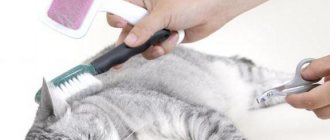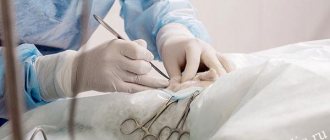What is better for animals: laparoscopic sterilization or ordinary abdominal surgery?
Removal of reproductive organs from an animal can be a simple abdominal surgery or laparoscopic sterilization of dogs/cats. Owners often doubt how best to sterilize a cat/dog and which method to give preference to.
If it is decided to perform laparoscopy on a cat or dog, then it is necessary to take into account all the pros and cons of the procedure. Advantages of laparoscopic sterilization of cats (dogs):
- absence of postoperative suture;
- the animal recovers quickly after laparoscopy;
- there is no need to process postoperative sutures;
- blood vessels are ligated and cut off using ligash technology.
Disadvantages of laparoscopic surgery:
- duration of the animal's stay under anesthesia;
- if the trocar is inserted unsuccessfully, bleeding may begin;
- Injury to internal organs (spleen, intestines) is possible.
Abdominal surgery has the main disadvantage - the presence of a postoperative suture (up to 4 cm), which must be processed until the sutures are removed no earlier than 5-7 days later. There is also a high risk of consequences of varying levels of complexity.
In any case, preference should be given to the method that the veterinarian knows best, since only a technique mastered by a specialist to the smallest detail will allow sterilization to be carried out in the best possible way and with a minimum of undesirable consequences.
Laparoscopic sterilization of a dog at Alisavet
To carry out humane laparoscopic sterilization, we use the latest endoscopic equipment - LigaSure bipolar ligation technology from B.BRAUN AESCULAP® CAIMAN®.
With the help of such equipment, the removal of the ovaries and uterus occurs by cutting tissue while simultaneously sealing the blood vessels (there is no need to apply internal sutures), which eliminates even the slightest bleeding.
Unlike other veterinary clinics, Alisavet has controlled inhalation anesthesia and an anesthesiologist - we believe that your pet deserves high-quality anesthesia used in humane human medicine.
03/09/18 Safe anesthesia. Inhalation (gas) anesthesia.
Thanks to gas anesthesia, your pet will easily wake up after sterilization and leave the clinic on its own paws.
Types of sterilization of pets and what are their differences
The procedure for sterilizing a cat by laparoscopy can be carried out using 2 methods:
- Tubal ligation. Females remain in estrus and have a high risk of inflammatory processes in the reproductive organs.
- Complete removal of the ovaries without affecting the uterus. Estrus stops completely, but there remains a fairly high risk of developing uterine pathologies.
- Removal of the uterus along with the ovaries. Not only does the animal stop estrus, but the risk of pathologies of the pelvic organs is also minimized.
In addition, chemical sterilization can be used for cats, which involves implanting a hormonal implant under the skin. When laparoscopy is performed on a cat, the procedure is called castration and involves the removal of the testes from males. Laparoscopy in dogs is similar to that in cats. Dogs undergo castration, and females undergo ovariohysterectomy, oophorectomy, or tubal occlusion.
How and where is the best place to sterilize a dog?
- even something as simple as sterilization - painful thoughts arise. How to do it better? Laparoscopic or abdominal surgery? Where to do it and how to choose a doctor? So as not to hurt and without suffering. And so that after the operation there will be no injections or procedures.
Let's try to explain in order: laparoscopic sterilization, abdominal techniques, and microlaparotomy perform the same thing - the uterus is removed along with the ovaries. So which way is better? The answer is simple: the one that the doctor knows better. But priority, given the possibilities of choice, should still be given to modern and low-traumatic techniques. They have certain advantages compared to classical methods: 1 . Reduced operation time. Minimally invasive sterilization of a cat, dog or ferret takes no more than 15 minutes. And the surgical procedure itself (this is the time when the instruments are inside the abdomen) - 5 minutes. . What gives: less anesthesia load, absence of infectious risks, minimization of injury. 2 . The seam after sterilization does not exceed 5-10 mm. . What it gives: no pain and no need to treat the seam. 3 . Fast recovery after surgery. . What it gives: within 2 hours after the operation, the animals are allowed to eat and lead their usual lifestyle. 4 . Operated cats and dogs do not need any injections, medications or care at all. . What it gives: no post-operative stress. 5 . And finally - just cheap. If we add up the cost of abdominal surgery and the costs of postoperative care, it turns out that minimally invasive operations are noticeably cheaper.
Minimally invasive sterilization is guaranteed to remove the uterus and ovaries, without complications. We have listed the main advantages of minimally invasive methods of sterilization of cats and dogs. However, there are still many veterinarians, including those with experience, who actively dispute their advantages, proving the benefits of abdominal operations. And that's their right! We repeat: the best technique is the one that the doctor knows well. There are many excellent surgeons still using silk as a suture material. Despite the fact that there have long been a lot of more convenient and less reactive synthetics. There is a habit and there are beliefs. And it is the right of everyone, individually, to have their own point of view. And on a massive, global scale, modern surgery requires, of course, completely new approaches. That is why endoscopic treatment methods are being actively introduced in both medicine and veterinary medicine and minimally invasive surgery departments are being opened. You can't argue with progress. And we consider laparoscopic sterilization a modern and humane way to regulate birth rates and maintain health for our pets.
PS However, there are times when minimally invasive sterilization of a dog or cat can turn into abdominal surgery. In our country, according to statistics, this happens in 3% of cases. The main reasons are: pregnancy for more than 2 weeks and ovarian cysts or tumors with a diameter of more than 1 cm. Therefore, the main rule of minimally invasive surgery: during such an operation, the next table is always set for the opportunity to switch to conventional abdominal surgery.
Doctor of Veterinary Medicine M. Shelyakov
At what age is it better to sterilize a pet?
At what age can sterilization be carried out for each animal is decided individually in consultation with a veterinarian, but there are certain standards:
- Sterilization of a dog (male) is carried out until it has completely matured (9-12 months).
- For female dogs, veterinarians recommend sterilization 8-10 months after the first heat.
- It is better to castrate a cat after 7-8 months. It is important that puberty has already passed, otherwise such a procedure may somewhat slow down its development.
- It is recommended to sterilize your cat the old fashioned way after the first heat. But modern research shows that earlier sterilization ensures better tolerance of the procedure and faster recovery.
In any case, laparoscopy of animals should be carried out by experienced specialists who, when examining the pet, will determine the advisability of such a procedure at a certain age.
Preparing your pet for surgery
Laparoscopic sterilization is performed without preparation only in emergency cases. For elective surgery, preparation for the procedure involves the following:
- A set of measures for the treatment of helminthiasis in cats/dogs.
- Trimming nails to protect the animal from injury while recovering from anesthesia.
- The animal must be vaccinated, and at least 20 days must pass from the date of the last vaccination to the scheduled laparoscopy.
- Laparoscopy is performed only on healthy animals, so they should first be fully examined.
- On the eve of a planned operation, the cat or dog should not be fed for 12 hours before the scheduled laparoscopy, and should stop drinking 3-4 hours before.
If you ignore the last point, then after surgery to remove the reproductive organs, the animal may vomit after the operation, and this is not desirable for fresh sutures.
How is the operation carried out?
During laparoscopic sterilization of dogs, mask anesthesia is used. All manipulations are performed using a laparoscope. To access the internal organs and carry out sterilization, 2-3 punctures are enough, through which endoscopic instruments and a video camera are inserted to visualize the process.
When sterilizing a cat using the laparoscopic method, small holes of 3-10 mm are made. A special endoscopic instrument is inserted into the peritoneal cavity and peritoneoscopy is performed, followed by an ectomy. At the end, the punctures are tightened with self-absorbing thread or filled with glue. Sterilizing a cat at home is not advisable, as it may require the use of complex equipment.
What is laparoscopic sterilization, the procedure for performing the operation
The name of the technique comes from the term “laparoscopy”. This term describes a diagnostic or other procedure where a small incision is made in the pet's abdomen and the internal abdominal organs are examined.
Accordingly, with the laparoscopic method of sterilization, a small incision is also made, through which the surgeon removes the reproductive organs (i.e., excises the uterus and ovaries). To find them, a laparoscope (the same endoscope) is used.
The operation itself goes as follows:
- One incision is made on the previously shaved and disinfected skin of the abdomen. Its length is no more than 3 centimeters; in the case of young animals, specialists make do with a centimeter incision.
- A laparoscope is inserted into the hole, with the help of which a specialist finds and fixes the organs to be removed.
- Using appropriate instruments directly inside the abdominal cavity, monitoring the process using a laparoscope camera, the veterinarian applies a ligature, sutures, and excises the organs of the reproductive system.
- The removed uterus and ovaries are pulled to the incision site and removed into the external environment.
- The incision site is sutured, and literally a couple of stitches are required.
Caring for the animal after the procedure
During the first time after surgery, animals require special care. Owners should pay attention to the following points:
- Postoperative blanket. After laparoscopy, the abdomen should be protected with a special bandage (blanket) secured to the back. This is necessary to protect against contamination and the animal licking small wounds from threads.
- Treatment of postoperative sutures. In the case of laparoscopic sterilization, these are punctures with a self-absorbing thread, which are rarely treated with antiseptics. It is enough to protect them from infection with a bandage.
- Proper nutrition. It is important to carefully select the diet and provide only fresh food, and special foods are also allowed. These foods for sterilized animals have been specially formulated to help the body recover after surgery.
Caring for dogs after sterilization is practically no different. If the dog is constantly trying to remove the blanket to get to the punctures, then it is advisable to put an Elizabethan collar on it.
Advantages of laparoscopic sterilization
Like any surgical intervention, although it is minimally invasive, it has a number of positive aspects and contraindications. The advantages of sterilizing dogs using the laparoscopic method are:
- The use of instruments that significantly reduce the negative impact on nearby organs during sterilization (the laparoscope is inserted accurately and allows you to remove only those tissues that are necessary, without affecting the vessels and tissue structures located nearby).
- Maximum sterility – when inserting endoscopes into the abdominal cavity, sterility is maintained, since all elements of the equipment do not come into direct contact with the veterinary surgeon’s hands (the risk of infection in the abdominal cavity and further development of peritonitis is minimized).
- Small stitches that heal quickly. The animal does not need to put on a special blanket and wear it for 7-10 days. The small entrance hole is so small that the risk of licking is practically impossible. The suture material has the properties of self-absorbing and leaving no marks.
The advantage of laparoscopic sterilization is that during the surgical procedure, the veterinarian has the opportunity to examine the abdominal organs. This allows you to identify possible pathologies, in addition to problems in the reproductive system. In addition, during laparoscopic manipulation, it is possible to immediately remove the pathological focus.
Unlike the cavity sterilization method, caring for a dog after laparoscopy is as simple as possible, and there is no need to inject the pet with additional medications.
The positive aspects of laparoscopy include the fact that the risk of developing adhesions in the intestines and other internal organs is minimized, in contrast to abdominal surgical interventions.
What complications can there be?
Laparoscopic sterilization is considered a fairly safe procedure, but there are always certain risks. Possible complications:
- Bleeding in the abdominal cavity. It may occur due to insufficient efficiency of coagulation of the uterine vessels.
- Orifice suppuration after laparoscopy. This can happen if dirt gets into it.
- Formation of a lump at the puncture site. This is how granulation tissue grows so much that it goes away only 3-4 weeks after laparoscopy.
Internal bleeding can be caused by an insufficiently performed operation or the animal falling/jumping when recovering from anesthesia, so owners should be especially attentive to their pet during this period.
How much does laparoscopic sterilization of cats and dogs cost?
The price for sterilization depends on the following criteria:
- complexity of the operation (planned/emergency);
- age, weight and general condition of the animal;
- time spent on laparoscopy;
- quality and quantity of consumables;
- qualifications of a veterinarian.
To perform laparoscopy, you must contact a trusted veterinary clinic and be prepared to pay an average of 4,000 to 6,000 rubles.
Laparoscopic sterilization is a modern way to rid your pet of unwanted offspring and many other problems. The procedure with miniature punctures (without an incision on the abdomen) and a shortened rehabilitation period will allow the animal to return to normal life within 24 hours.











